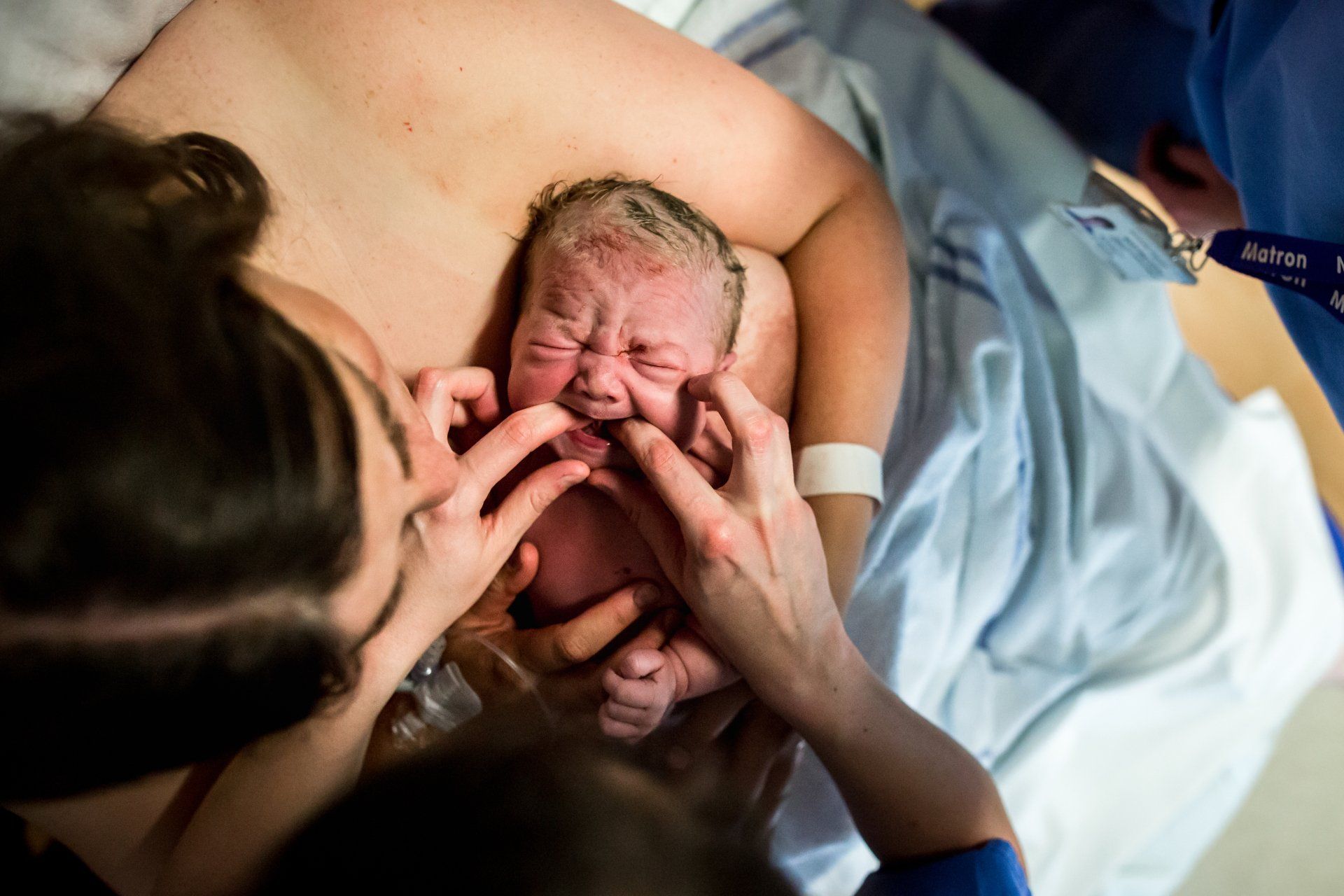Why an 11 minute labour isn't the easy option...
Helen Pierce • 22 May 2021
Why I gave birth in a car park, and other stories...
When you tell someone you have had very quick labours, the reaction is pretty universal. “Lucky you”, “Gosh, I wish I did”, “Oh that’s nice and easy for you”. Of course, I have no alternative experience to compare with, but as a veteran of 6 precipitous labours, I feel qualified to say it isn’t the easy option.
The National Institute for Health and Care Excellence (NICE) states that first time mothers typically experience a labour of 11-21 hours, with those who have given birth before typically experiencing a shorter labour of 7-14 hours.
About 2% of women will experience a far quicker labour than this: a phenomenon called Precipitous Labour which varies a little in its definition but is broadly used to describe labours which are less than 3 hours in duration from the onset of contractions. Although precipitous labour can take people by surprise, there are some circumstances which make it more likely to occur.
*There is a higher chance of precipitous labour when:
*The baby is smaller and/or well positioned in the birth canal;
*The birth canal is wider, which can be naturally occurring or influenced by previous births
*There has been a history of previous precipitous labours, either for this pregnant women or for close relatives.
*The labour has been induced using oxytocin or prostaglandins.
The combined length of my own six precipitous labours, as recorded on my maternity notes, is just under 5 hours in total: less than half the average length of a first labour.
I can appreciate why it sounds like the easy option, and I certainly don’t claim that I would have preferred longer than average labours. However, as someone who has variously given birth in a car park, a bath and a hospital storage room, as well as two delivery suites and a rather wonderful home birth, I want to shine a spotlight on some of the realities of a fast labour.
A woman who experiences precipitous labour has a higher chance of:
* Heavier bleeding after the birth;
* Perineal and cervical tears;
* Giving birth without medical assistance, and without pain relief;
* Retained placenta;
* Postnatal depression;
* Difficulty with initial bonding with the baby;
* Injuries to the baby resulting from fast labour or suboptimal place of birth.
Part of my role as an antenatal educator is to talk to expectant parents about how they will know it is time to leave for their planned place of birth. There are generally two concerns: what if we make our way too early and are sent away again; what if we wait too long and the baby is born before we arrive at our place of birth.
The popular school of thought is to wait at home for as long as the woman feels able. Her oxytocin levels are likely to be higher there as she is in her safe space and more able to control her environment. This needs to be tempered with the very real hormonal impact of making the journey in to wherever the woman plans to give birth. Car journeys can be particularly uncomfortable for a labouring woman. From my privileged viewpoint as a Paramedic, the same can be true of ambulance journeys. Even a small baby is quite big in comparison to the birth canal they are descending through, and there are some considerable turns within labour which a baby has to negotiate, which can make sitting down feel particularly uncomfortable. Discomfort and pain push oxytocin away and invite in adrenaline, which has a stalling effect on labour, and so it is clear that keeping a woman as comfortable as possible during her labour is a good thing.
When considering when a woman should make her way towards her planned place of birth, the recommendation is to wait for labour contractions to feel regular and active, to wait for a clear pattern which indicates that the birth process is progressing and that labour is less likely to stall.
This makes perfect sense in terms of optimising that oxytocin-rich home environment, and gives the labouring woman an opportunity to build up the endorphins in her body which will enable her to cope more naturally with the pains of childbirth. Overall, the picture is a beautiful one. A heavily pregnant woman, breathing and moving in a way that helps her baby to descend through her pelvis, and allows her to feel in control and capable as her labour gradually progresses from early into active labour.
By contrast, the picture of a precipitous labour can look very different, particularly for someone who doesn’t know this is how their body will give birth.
In precipitous labour, a woman may not experience contractions until they become very intense, seemingly without build up and without a meaningful break between them. Alternatively, she may be aware of seemingly early contractions which feel very manageable in their nature, but then progress suddenly and without warning. A common feature of precipitous labour is the feeling that contractions are arriving one on top of the other, not allowing the woman to recover from the last before the next crashes over her. As well as feeling very intense in their nature, these relentless contractions can create a sense of panic in the woman who doesn’t understand what is happening and believes something must be wrong. In some rare instances, the first sign of precipitous labour can be the urge to push.
My own fastest labour took just 11 minutes. I was in the hospital already, undergoing an induction as I was now weeks past my due date with my second baby, and I was ready to no longer be pregnant. I had spent 24 hours with a pessary in place which, even before the midwife checked me, I knew hadn’t had the desired effect. She removed the pessary and I consented to a vaginal examination to understand how my cervix had responded to it. My cervix was described as being a long way back, almost unreachable, still firm and closed. My Bishop’s Score, an assessment tool used to describe the apparent likelihood of a cervix to respond to induction, was low. The midwife confirmed what I already knew, that there was nothing to suggest labour was likely to start soon, and offered to run me a bath in the hope the relaxation might be useful. As I walked down the corridor to the bathroom, I had a sudden, and very strong, contraction. The gradual build up of contractions during labour serve to increase endorphins, making a woman more able to bear the increasing intensity as labour progresses. In my case there had been no build up. Just minutes earlier I had been told my chances of going into labour that day were pretty slim, yet that first contraction left me in no doubt that it had happened. Once the sensation eased, I continued walking to the bathroom and as I raised my leg to step into the bath, I had another contraction and felt the familiar sensation of something being born. I asked my husband to look between my legs as I was sure there would be a head, and he replied that I ‘wasn’t in labour’ so not to be silly. I asked again and this time he looked briefly before shouting for someone to come and help. My son, still in his waters, was being born. From my viewpoint, things get a little blurry around that moment. I know a lot of people rushed into that small bathroom, and I remember someone not being sure if I should put my second leg into the bath, or take the first leg out again. As I stood there awaiting further instructions, someone let the bath water out. I was told to climb fully into the bath and in one further contraction my son was born. I think back now, with 6 births to reflect on, and I remember the moment of birth with everyone except my second-born. His labour was recorded as a 0 minute first stage, and an 11 minutes second stage. As I sat holding him a short while later, I remember not quite being able to connect the baby in my arms with the one I knew had been inside me for all those months. We had picked his name out in pregnancy but I kept saying it over and over as I looked at him and it didn’t feel right to use it, because that name belonged to my baby and this couldn’t possibly be him because we hadn’t had a labour.
Much of my son’s birth is a blur, as you can imagine, but I have one very clear memory before the push that brought him into the world. I hung my head down and said ‘I’m just so tired, I can’t push’ and a midwife rolled her eyes and said ‘you’ve only had two contractions, how tired can you be?’.
Let me put on the record now that a woman who gives birth is allowed to feel exhausted. However her birth has unfolded and however long she might have spent in labour. She has just grown a human inside of her own body and has gone through whatever might have been her experience in order to give birth.
In my case, my cervix had dilated from 0 to 10 cm in one contraction, after a long night with not much sleep, and yes, I was exhausted.
The midwife’s comment, though, only serves to highlight the common experience of women who have a precipitous labour: It didn’t take long, that’s lucky. You can’t be as tired as someone who has laboured for a much longer time. It is perhaps indicative of our culture, of the need to compare everyone and declare someone to be the most hard done by.
Precipitous labour can be a very stressful and even traumatic experience, particularly for someone experiencing it for the first time. It can be helpful to know how to manage the stress of a very quick progression of labour:
* Breathing techniques can be very helpful for regaining a feeling of control and encouraging oxytocin and endorphin production, which can assist with pain relief and encourage bonding.
* Trust the labouring person’s instinct. If they feel that labour is progressing unusually quickly and with little respite between contractions, it is quite possible that they are experiencing precipitous labour.
* If this occurs when they are not in their planned place of birth, consider calling medical help to the woman rather than trying to get to a place where she can receive medical help.
* If she has the urge to push, call 999 rather than the hospital as it is important to have medical help on the way as soon as possible.
* Ensure medical help is able to reach you by leaving your front door open/on the latch. The woman may wish to lay on
her side whilst waiting for assistance to arrive.
An overwhelmingly common theme of positive birth experiences is the feeling of being in control, something which can be far less prevalent in a precipitous labour. Where labour has felt particularly uncontrollable, it can be especially important to foster a sense of control in the immediate postnatal period. Prioritising skin to skin between the mother and the baby aids bonding and has the added benefit of assisting with bleeding control in a birth situation where there is an increased chance of heavy bleeding. It is also important that a mother is made to feel validated and heard when she shares her birth story. Yes, her labour was fast and it sounds to many like that would be a positive thing, but she may have experienced that labour in a very different way and this should be acknowledged, not minimised.













